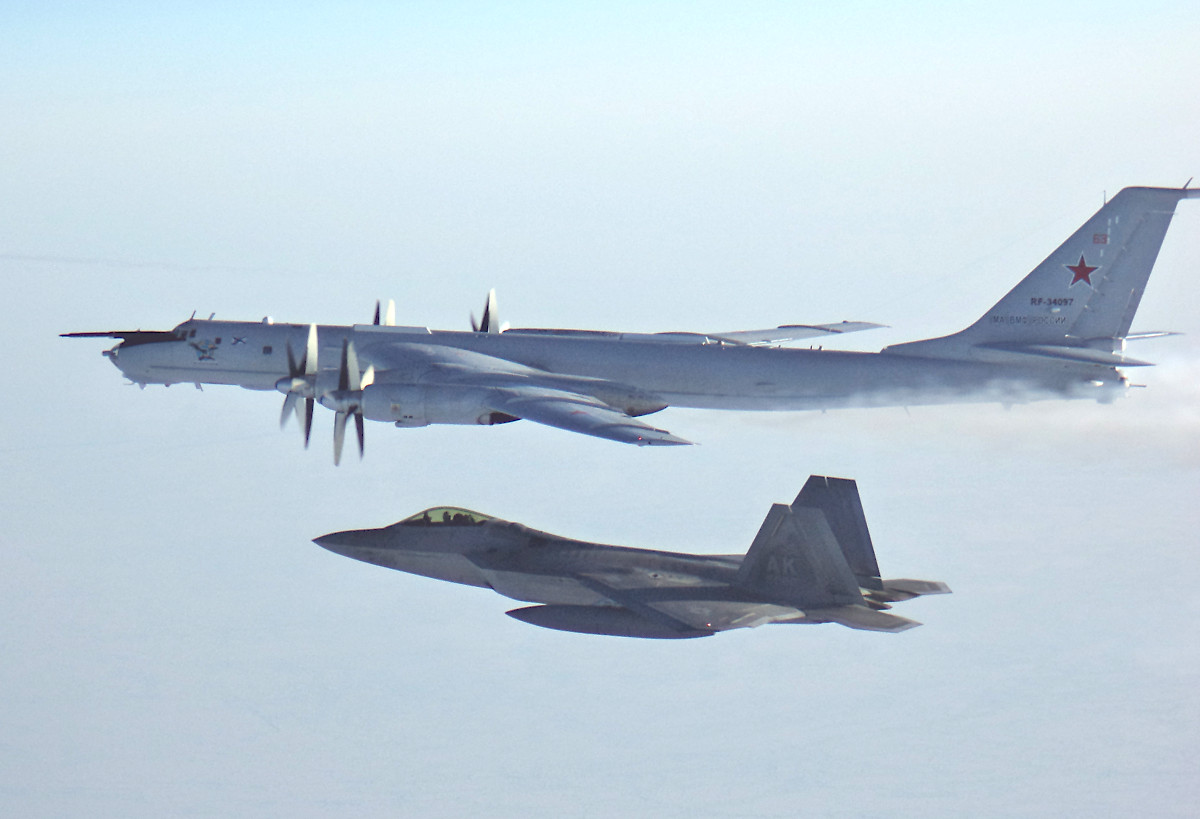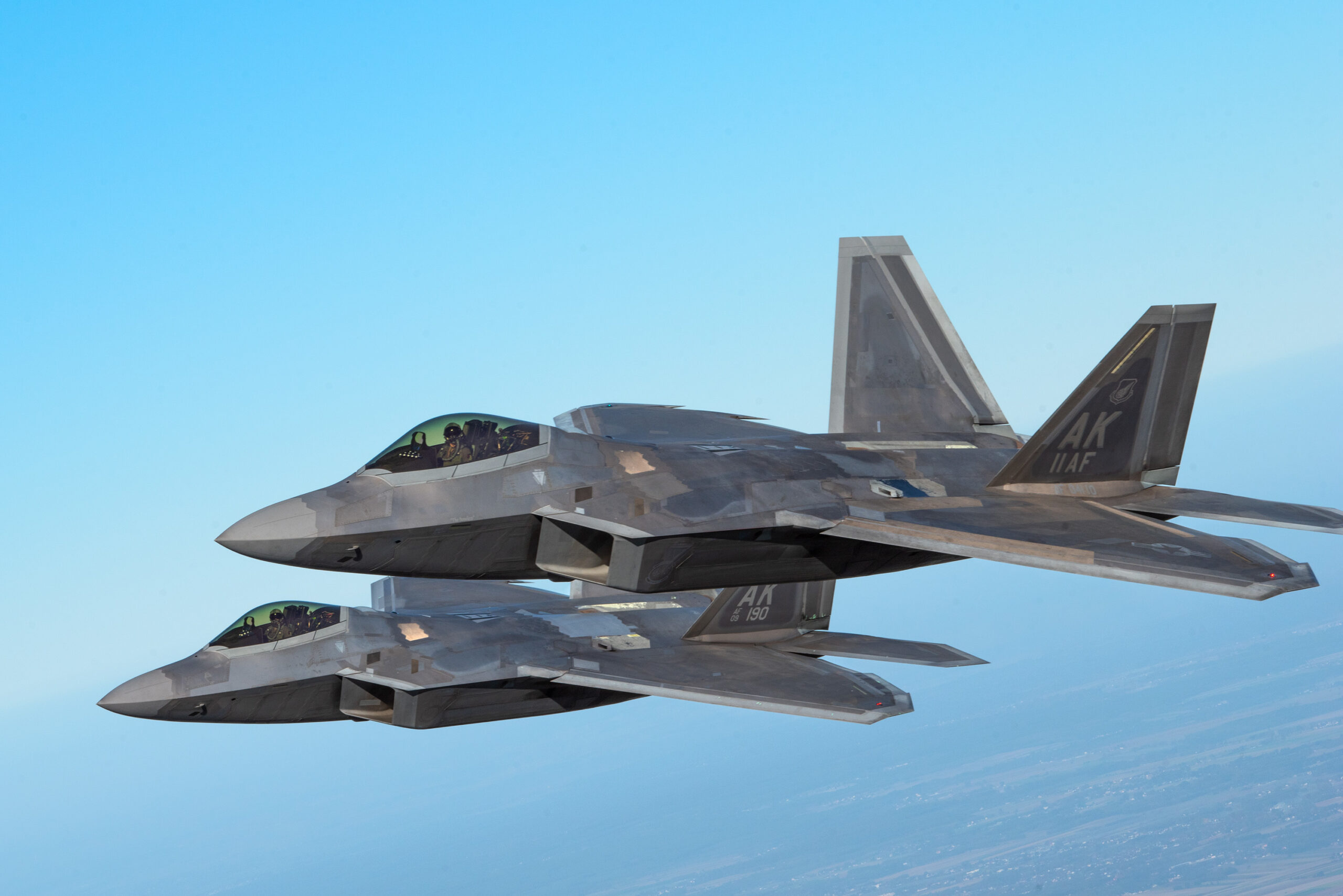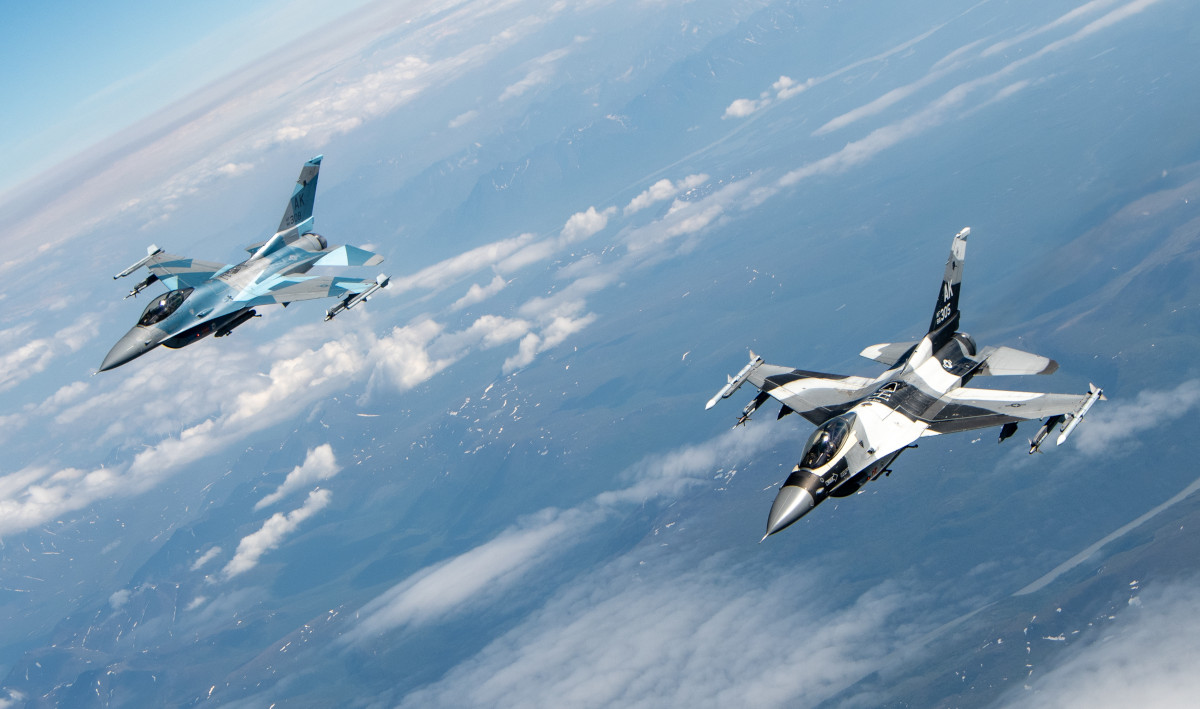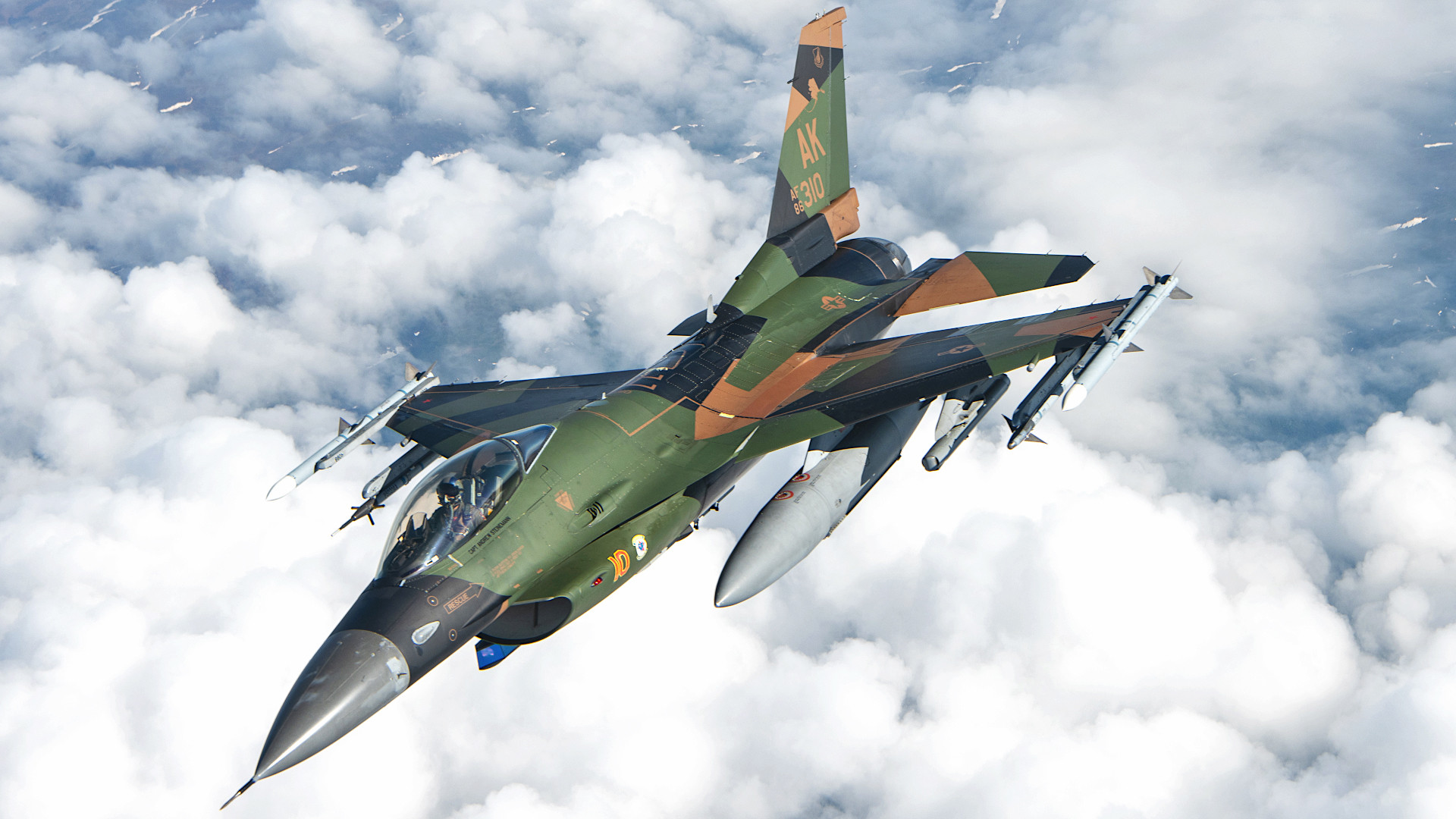Photographs of F-16C Viper fighter jets assigned to the U.S. Air Force’s 18th Aggressor Squadron at Eielson Air Force Base in Alaska armed with live AIM-120 Advanced Medium Range Air-to-Air Missiles, or AMRAAMs, and AIM-9X Sidewinders have emerged online. Separately, the Air Force has all but confirmed to The War Zone that aggressor F-16s were used to intercept two Russian Tu-95MS Bear bombers after those aircraft entered the Alaskan Air Defense Identification Zone earlier this week. The crews of those Bears may well have been confused to see jets sporting elaborate camouflage and Russian-style red bort numbers pull alongside them.
F-22 Raptor stealth fighters from Joint Base Elmendorf–Richardson in Alaska, which has established alert facilities, supported by E-3 Sentry Airborne Warning and Control System (AWACS) aircraft and KC-135 tankers, are typically used to intercept foreign military aircraft entering the Alaskan Air Defense Identification Zone (ADIZ). That aggressor units equipped with F-16s, which are tasked to provide mock adversaries for exercises and other training and test activities, have secondary homeland defense roles at all is not well known. The War Zone has explored this in the past in regard to the 64th Aggressor Squadron at Nellis Air Force Base in Nevada.
Twitter user Aerospace Intelligence posted pictures showing three F-16s from the 18th Aggressor Squadron in hangars (likely alert barns) with live AIM-120s and AIM-9Xs – readily identifiable by the yellow and brown bands around portions of their bodies that denote the presence of an explosive warhead and rocket motor – earlier today, saying they had received them from an anonymous source. The Tweet also said that Vipers from this unit had conducted the intercepts of the Tu-95MSs, which had occurred on October 17.
It’s unclear which, if any of the jets seen in the pictures might have flown those particular sorties. However, having three jets available is standard procedure, as the missions typically involve two fighters, with the third providing a backup in case something sidelines one of the primary aircraft sitting on alert. Sometimes a fourth jet with its gun loaded only is also available, and sometimes additional alert jets are on standby for various circumstances.
“The F-16s that conducted the intercept were assigned to support the Alaskan NORAD [North American Aerospace Defense Command] Region mission,” Air Force Maj. Lauren Ott, a spokesperson for the Alaskan NORAD Region, U.S. Alaskan Command (ALCOM), and 11th Air Force, separately told The War Zone in a statement. “However, the F-16s are regularly assigned to INDOPACOM [U.S. Indo-Pacific Command] and are based out of Eielson.”
The 18th Aggressor Squadron at Eielson, which is assigned to the 354th Fighter Wing, is the only unit of any kind based in Alaska that operates Vipers. The 354th Fighter Wing is part of Pacific Air Forces (PACAF), the top Air Force command within INDOPACOM.

NORAD’s official press release regarding the intercepts on October 17, which came the day after, did not say what unit the F-16s belonged to or where they had flown from in this particular instance.
“The recent Russian activity in the North American ADIZ is not seen as a threat nor is the activity seen as provocative,” NORAD’s press release added. “NORAD tracks and positively identifies foreign military aircraft that enter the ADIZ. NORAD routinely monitors foreign aircraft movements and as necessary, escorts them from the ADIZ.”
As already noted, that Air Force aggressor squadrons have secondary homeland defense missions is a known, but obscure fact. These squadrons do not generally have jets sitting on continuous alert to conduct these kinds of intercepts, but can be spun up to execute the mission if necessary. The skill sets required for NORAD-supported alert operations are unique and take recurrent training to keep crews certified to execute them. They are also very resource intensive, with multiple jets being dedicated to the mission at any given time.
This is especially taxing for Raptor units as the type is a notoriously maintenance-intensive aircraft, and the Air Force’s fleet of these stealth jets, overall, has equally notoriously low readiness rates. In the 2021 Fiscal Year, the F-22 fleet’s overall average readiness rate was just under 51 percent, according to data obtained earlier this year by Air Force Times. So, if a squadron has say 21 aircraft, three of which are back-up inventory, and the mission capable rate is around 50 percent, and three or four of the flyable jets have to also stand alert, you see how this leaves few airframes left for training and actual deployments.

In this specific instance, the 90th Fighter Squadron at Joint Base Elmendorf–Richardson in Alaska sent 12 of its approximately 24 F-22s to Poland earlier this year, where they are still flying as part of NATO’s Air Shielding mission. NATO began conducting this mission as part of broader efforts to bolster the alliance’s posture along its eastern flank in response to Russia’s all-out invasion of Ukraine.

The deployment of roughly half of the 90th Fighter Squadron’s total F-22s has effectively cut the number of Raptors in Alaska by a quarter. How many of the remaining jets in the region – additional examples are also assigned to the 525th Fighter Squadron at Elmendorf-Richardson – are currently able to fly at any one time is unclear and many of those that are could very well be tasked to other assignments.
All told, it’s not hard to see how the 18th Aggressor Squadron may have been called to step in to provide critical additional capacity for the homeland defense mission and units trained in the homeland defense mission often cover or augment other units. The South Dakota Air National Guard’s F-16s have long provided quick reaction alert capacity at March Air Reserve Base in Southern California even though the California Air National Guard, equipped with F-15C/Ds, has the overall NORAD mission in the state. Another example came during the prolonged grounding of the F-15C/Ds after one of the jets disintegrated during training due to a structural failure. In that instance, stateside F-16s covered the F-15’s alert commitment at Elmendorf in Alaska, as well.
“The employment of the F-16s in support of the Alaskan NORAD Region mission demonstrates the diversification of aircraft capable of doing so and allows for a resilient and flexible force with personnel capable and familiar with operating in Arctic conditions,” Air Force Maj. Ott had said, as a general comment, in her statement. “Simultaneously, it ensures readily available airpower capabilities to support other requirements in the NORAD and NORTHCOM Joint Operations Area as well as in the INDOPACIFIC.”

There only looks set to be more need for this kind of diversification in the Pacific, in particular, given the combination of increasing security challenges posed by China, and to a lesser degree Russia, in the region and growing demand for F-22s to at least be available for major contingencies abroad. Russia has been more active, and at times more provocative, in conducting long-range bomber and maritime patrol aircraft sorties into the Alaskan ADIZ in recent years.
The Air Force has been notably criticized in the past by the Government Accountability Office, a Congressional watchdog, for utilizing the relatively low-density Raptor fleet for routine homeland defense intercept missions, which increases the wear and tear on the already maintenance heavy jets, among other things. F-22s flying intercept sorties carry external drop tanks and therefore do not make use of the jet’s stealth or supercruise capabilities, either.
At the same time, this doesn’t automatically mean the 18th Aggressor Squadron is likely to take up a more permeant role in the homeland defense mission in Alaska. The Air Force has worked to establish a major force of stealthy F-35A Joint Strike Fighters in the region in recent years, which could provide crews and jets to sit alert. Demand for aggressors in their primary role is only increasing, as well, including to support increased training requirements and larger exercises in and around Alaska.
Still, as was demonstrated this week, the 18th Aggressor Squadron, and similar units elsewhere in the United States, stand ready to be called upon to help guard the nation’s airspace if required.
Editor’s Note: The Tweet with the pictures of the armed 18th Aggressor Squadron F-16Cs has since been deleted.
Contact the author: joe@thedrive.com
